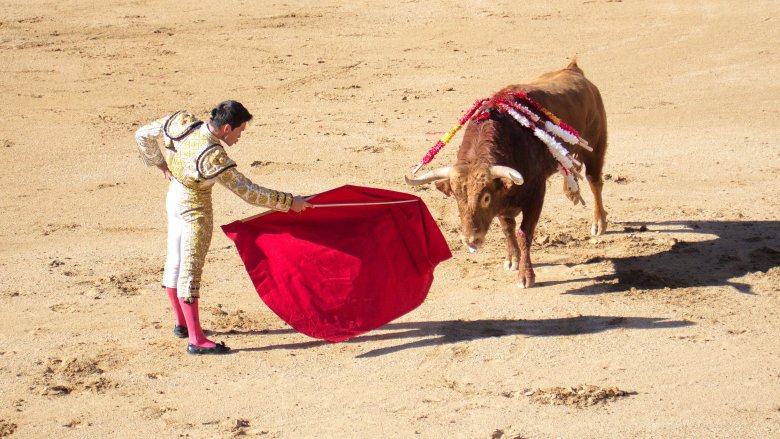Things You Believed As A Kid That Ended Up Being Wrong
Parents try to raise their children properly, passing on virtues, life lessons, and wisdom gleaned from their own experiences. Along the way, both peers and elders cram our heads full of questionable tidbits and dubious factoids that lodge in our brainpans. In the long run, most of these kiddie truths turn out to be total bunk, including the following fallacies.
Human beings evolved from apes
Aside from folks led to believe humans just *poofed* into existence a couple millennia ago, most people are familiar with the well-vetted theory of evolution. Single-celled organisms adapted into complex creatures, becoming fish, mammals, and then higher primates, loosely speaking. Last but not least, humans evolved from apes. Actually, that's not quite correct, either. A favorite argument of evolution disbelievers supposes that apes wouldn't still exist if we evolved from them. But according to the National Center for Science Education, our current understanding of humanity's development suggests that humans didn't directly evolve from our simian cousins. Instead, we share a common, ape-like ancestor — somewhere along the line, our ancient ancestors walked down a different path than other primates.
The progression of human evolution looks more like a gnarled family tree than a straight line, with several branches forking off when different simian species diverged from the path. From that point, human beings still split off into several distinctive proto-human groups, consisting of the Australopithecus, Ardipithecus, Paranthropus, and Homo group, to which modern Homo sapiens belong.
So, are we descended from apes? Not exactly. Are we related to them? Absolutely, but we're more like a fifth cousin with a few great-great-great-grandparents in common.
The vomitorium is a place for Roman 'purging'
The excesses of the ancient Romans are often explored in classrooms, which is why many kids aren't surprised by Rome's most disgusting architectural feature: the vomitorium. Supposedly, ruling members of the toga-clad civilization would dine on the succulent treats and wines of the day before purging themselves at the appropriately named venue. But as revoltingly opulent as Rome's ruling class was, it wasn't that bad.
If anything, Roman scribe Macrobius was guilty of being too creative with his metaphors. The author first referred to a "vomitorium" in his book Saturnalia. Rather than a nasty stadium, though, he was really describing the entryways to an auditorium. Classics professor Sarah Bond cleared up the misconception in an interview with Scientific American, noting that "the adjective 'vomitus' already existed in Latin" and basically meant to "erupt out of" something. Acting along the traditions of his day, the Roman wordsmith combined the root word with the suffix "-orium" to denote a location. So vomitoriums are literally places where the crowd "spews forth" from the auditorium — which also paints a vivid picture of Macrobius' feelings towards post-show traffic.
Somewhere around the late 19th century, people misread the context of the word, holding up vomitoriums as yet another sign of Roman corruption. Their misnomer is understandable, though, since writers of day often inflated the indulgences of the elite to delicately satirize their leaders. Later, authors like Aldous Huxley and Suzanne Collins mistook poetic license for fact, though, perpetuating the myth of Rome's stadium-sized air sickness bags.
Waking a sleepwalker could hurt them
Many people have walked in their sleep or know someone who has, typically as a child. Fortunately, the general public is properly versed in dealing with sleepwalkers since the shock inflicted from waking a sleepwalker can harm them. But as it turns out, that piece of common wisdom is way, way off.
Stirring a sleepwalker is actually a great idea, but not because they're in danger of being turned into dream-killer mincemeat by Freddy Krueger. As Scientific American notes, allowing the walkers to amble on actually exposes them to a number of potential dangers. In extreme cases, some sleepwalkers managed to get behind the wheel and drive their cars. Sleep researchers have even noted cases where the unconsciously-abled engaged in sexual activities, got into fist fights, or whipped up a meal, all of which are already risky enough for conscious people.
In most cases, sleepwalkers seem content to shuffle from room to room, but unconsciously walking around the house is still fraught with perils, such as stubbing a toe, falling down a staircase, twisting an ankle, or even walking into the street. If faced with a sleepwalking spouse or friend, feel free to gently remind them that the waking world is best left to the fully conscious. And be ready to duck if they swing at you.
Bats are blind
Countless children grew up with the expression "blind as a bat," perhaps even believing it was scientifically accurate. On the contrary, these creatures of the night actually have pretty keen vision.
According to a 2009 study detailed in Live Science, numerous bats use their eyes to hunt, only switching to their sonar-like abilities at night. Most fruit bats, which munch on plants instead of insects, have lost the ability to echolocate and now primarily operate by sight. In fact, Pallas' long-tongued bat and Seba's short-tailed bat are able to see many of the same colors humans can. Pallas' long-tongued bats even have a leg up on us: they can detect the ultraviolet spectrum, which helps them locate pale flowers among the darker foliage and sip out all that sweet, sweet nectar.
Other species, such as the brown-eared bat, like to mix things up. During the daylight hours, they scour the skies by sight. But when the sun goes down, they unite their vision and echolocation skills to maximize their bug hunts. Faced with all this eye-opening evidence, humans owe bats an apology.
Water boils quicker with a dash of salt
Despite modern conveniences like microwaves and toaster ovens, cooking still takes too damn long. To speed things up, many impatient chefs add a pinch of salt to the water. Unfortunately, they're not actually helping their cause.
As explained by Mental Floss, salting the water actually raises the boiling point of water. Essentially, salt's extra molecules overburden the water, forcing the heat source to work extra hard and jacking up the solution's boiling point from 212 to 216 degrees Fahrenheit. Without any time-saving benefits, salting the water becomes an unnecessary step in the process — unless you're making pasta, of course. In that case, people who enjoy real pasta often prefer their dish with a dash, while folks who like low-sodium fare can skip the added salt. Either way, supper will still hit the table at roughly the same time.
Bulls attack the color red
Looney Tunes isn't exactly a bastion of scientific accuracy, but Bugs Bunny is guilty of steering loyal viewers astray. During a classic episode, the wascawy wabbit faces down an angry bull, using the matador's scarlet muleta to trick the bull into charging into anvils and walls. Classic! But anyone daffy enough to think the color is what made the bull angry could be in trouble.
According to Live Science, cattle can't actually see the color red. What aggravates a bull in the ring is the movement of the matador's cape. During a potentially painful episode, Myth Busters put the bovine visual spectrum to the test. Throughout several rounds, the steer paid little attention to bright red flags or the rosy garb of the would-be matador, focusing on moving targets of other colors instead of red, stationary targets. The cloak's color actually comes from an ugly practicality. In the final round, matadors kill the bull and the red cape helps conceal all that blood.
Peeing in the pool makes the water turn colors
Putting summer fun on hold to scramble for the bathroom is a total drag. After all, nobody would notice if the tepid pool warmed up a degree or two, right? But one lazy act will release a colorful cloud or trail that leads right to the culprit. Unfortunately, pool piddlers can relax their bladders (please don't) since Snopes long ago debunked the so-called "urine-indicator dye." Even if such a chemical did exist, a pee-detecting chemical wouldn't be particularly effective. Pools already contain much of the same organic matter found in urine due to naturally occurring pollutants, sweat, and other bodily secretions.
Rumors of a chemical guilt-detector probably come from clever parents who wanted to stop their kids from using their own pools as outhouses. And they had good reason, too. In the right concentrations, a build-up of nitrogen from urine, sweat, and other pollutants can combine with chlorine to create chloramines. According to the Healthy Pools Blog, chloramines are responsible for those red, irritated eyes often associated with supposed over-chlorination. So, if the kids climb out of the pool with angry peepers, perhaps someone's been using the facilities beyond its intended function. Or just sweating a lot. Either way, maybe we should quietly let this urban legend live on.
Mount Everest is the world's tallest mountain
Mount Everest (which you're almost certainly mispronouncing) has long been heralded as the top of the world. Contrary to popular belief, though, the Himalayan peak isn't technically the tallest point on the planet.
According to Geology.com, the inspiring spire is actually the highest point above sea level at a whopping 29,035 feet. The true champion of mountains as measured from top to bottom, goes to Mauna Kea in Hawaii. Even though only 13,796 feet of the Hawaiian island juts above the waves, the mountain is an island, standing in the puddle of the Pacific Ocean. Measured from tip to toe, Mauna Kea is about 33,000 feet tall. To further confuse the issue, Mount Chimborazo in Ecuador is technically the "highest mountain above Earth's center," even though it only climbs to 20,703 feet above sea level. Thanks to the planet's wacky egg-like shape, which is fatter at the equator than near the poles, the top of Chimborazo is roughly 1.2 miles further from the planetary core than Everest's peak.
Labels matter, but Everest is still the most grueling ascent, at about two months round trip. That's a lot of time to climb a mountain that isn't even the tallest.
Touching a toad causes warts
Scouring marshy areas for frogs and toads is practically a childhood rite of passage. Anyone lucky enough to corner one of the slippery buggers, though, risks a stern warning from their peers. After all, picking up a toad is a surefire way to get warts. Or is it?
In his "Great Moments in Science" column, Dr. Karl Kruszelnicki clears up this logical leap. Warts are actually caused by the human papilloma virus (or HPV), a relative of the germ responsible for genital warts and cancer. Toads and their ilk have never and will never be wart-makers. In fact, their skin may have super-healing powers, at least according to biologist Michael Zasloff.
As Dr. Karl relates, Dr. Zasloff was impressed by amphibians' incredible restorative capabilities. While scrutinizing their skins, he discovered that their flesh contains antibacterial, anti-fungal, and even parasite-combating agents. Since their natural habitats are crawling with microbes, he speculated that frog skin developed properties to protect them from infection and allow them to rapidly regenerate under less-than-optimum conditions. So, touching a toad could actually help treat warts. Sorry for the years and years of discrimination, frogs.
Sitting too close to the TV ruins eyesight
As children, many of us learned that snuggling up to the TV was a big no-no. All the nasty beams pouring from the boob tube would wreck our eyes. As it turns out, those longstanding parental fears of video-related blindness are unfounded.
But the popular myth has a real-world origin. According to Scientific American, General Electric launched their latest line of color televisions in the early '60s. Unfortunately, these sets also came fully loaded with dangerous levels of radiation. Legitimate concerns about ocular damage forced GE to remove the faulty models from showrooms and living rooms everywhere. Since then, tales of kids blinded by their TVs have remained a popular urban legend.
Televisions won't necessarily wreck our vision, but as ophthalmologist Lee Duffner told Scientific American, getting too personal with our sets or watching them from unusual angles can cause serious eye strain. Fortunately, a case of fried eyes usually heals up after a good night's sleep. Crowding the idiot box might indicate nearsightedness, but it won't cause it. Watching too much TV, on the other hand, is an entirely different can of unhealthy worms.









